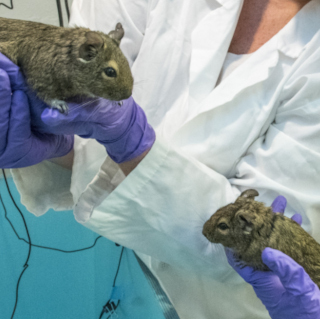Chemical Hazard Communication
Last Review Date: September 1, 2020
I. Purpose/Scope
The purpose of this program is to ensure that the University of Montana, Department of Laboratory Animal Resources is in compliance with the OSHA Hazard Communication Standard (HCS) 29 CFR 1910.1200 http://www.osha.gov/pls/oshaweb/owadisp.show_document?p_table=standards&p_id=10099.
II. Policy
It is LAR policy to meet or exceed all federal, state, and local regulations and guidelines and to comply with all institutional policies and procedures as they apply to the use of animals in research. Personnel must attend any applicable training in animal care and use, occupational health and safety, equipment operation, and SOPs prior to performing activities outlined in this SOP or work under the direct supervision of trained personnel.
III. Responsibility
The IACUC Coordinator and Facility Manager act as the representatives of the President of the University of Montana who has overall responsibility for the UM programs. Each employee in LAR will be apprised of the substance and content of the OSHA HCS, the hazardous properties of chemicals they work with, and measures to take to protect themselves from these chemical hazards.
IV. Procedures
A. Safety Data Sheets (SDS)
The LAR Facility Manager will maintain an SDS notebook on every hazardous substance in use by LAR. The Facility Manager will ensure that the SDS notebook is maintained and located at the entrance to animal facilities in the Health Sciences Building (HSB), Skaggs Building (SB), and the Field Research Station Fort Missoula (FRSFM).
B. Labels and Other Forms of Warning
C. Chemical Hazard
1. The SDS notebook is located in the right-to-know compliance center in the main
corridor just inside each animal facility entrance.
2. The primary chemicals used in LAR in large quantities are associated with the cage
washer and are stored in the dirty cage washing area. An emergency eyewash
station is located in the dirty cage washing areas of HSB, SB, and FRSFM. Rescue
concentrate is used to clean floors. Rescue RTU is used for cleaning surfaces such
as tabletops and stainless steel surfaces. Animal rooms are cleaned
RTU.
3. Isoflurane anesthesia is used in some procedure rooms. Doors are either marked
clearly with a yellow hazard sign or allow only limited access. Anesthetic gases are
scavenged either actively through house vacuum or passively using charcoal
canisters.
4. Some research projects in LAR facilities involve the exposure of animals to very low
levels of potentially hazardous substances such as asbestos, silica, and TCDD. The
rooms housing animals involved in these projects are well-marked by a magnetized
yellow sign on each door.
All LAR employees will receive initial training by the Facility Manager on the OSHA HCS and the safe use of hazardous materials in LAR. Additional training will be provided by the Facility Manager for all staff whenever new hazardous materials are introduced into the work area.
Training will emphasize the following:
1. The chemical properties of certain hazardous material including visual
appearance and odor.
2. Physical and health hazards associated with potential exposure to workplace
chemicals or other hazards.
3. Procedures to protect against chemical and biological hazards
a. Protective clothing/equipment may include (but are not limited to):
1) safety goggles
2) respirators
3) laboratory gloves
4) lab coats or disposable jumpsuits
5) BSL-2 cabinets
6) proper ventilation
b. Procedures to protect against hazards include (but are not limited to)
1) wear the correct protective clothing/equipment for the job
2) read all labels, and never place or use chemicals in an unlabeled container
3) never mix chemicals, or reuse empty containers
4) use common sense
c. Emergency procedures include (but are not limited to)
1) eyewash stations are located in the cage wash rooms in HSB, SB, and FRSFM;
flush eyes for 15 minutes and seek medical attention
2) wash skin with water (or check MSDS for other potential wash solutions)
3) report all accidents, chemical exposures, and unsafe conditions to the
Facility Manager as soon as possible
4. Hazardous chemical spill and leak procedures.
a. Spills that can be readily cleaned up by LAR personnel
1) wear gloves
2) wear protective clothing if necessary
3) keep area ventilated
4) use caution with broken glass
5) wipe up area with paper towels and place towels into biohazard bag
6) clean area thoroughly
b. Spills that may threaten life, health or property or spills where trained people
and/or proper clean-up equipment are not available within the lab or work
area
1) Before calling and reporting a biohazard spill, consider the following:
a) Personal exposure. If the spill may cause personal injury to yourself or
others, vacate the area.
b) Containment. If it is feasible to stop the spill from spreading or going into a
floor drain by containment, do so.
c) Prevent access. If others might come to harm by entering the area,
prevent access to the area.
d) Assessment. If you can do so without exposing yourself, determine the
type of material spilled and the extent of the spill.
e) Injuries. Determine the type and extent of injuries, if applicable.
2) In the event of a hazardous materials spill or leak, the following should be
notified:
a) Chuck Emnett 370-2870 cell
b) Kelly Carrick 243-4892 or 210-4700 cell
c) Kathy Heivilin 243-6395 or 370-5865 cell
d) In the unlikely event that the above cannot be reached, call 9-911 and
ask that the 'Health Officer on Call' be dispatched to the scene. Do this
only if it appears that the risk is imminent and that sealing off the area is
not sufficient.
5. Location of SDS notebooks, understanding the SDS
appropriate chemical hazard information.
E. Short-term Users Such as Contractors and Visitors
Located at the entrance to each animal facility is a file containing an Occupational Health and Safety letter from the Vice President of Research. This letter contains information regarding chemical hazards and other hazards within the animal facility that will be useful to short-term users.
